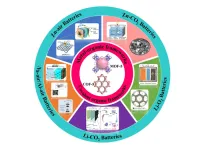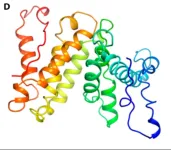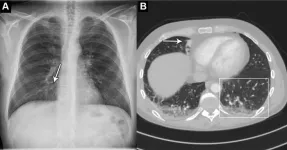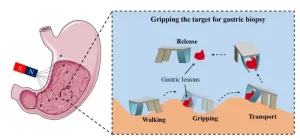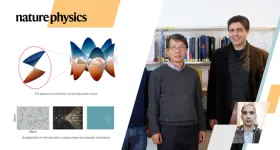(Press-News.org)
The selective breeding of grain crops is one of the main reasons why domesticated plants produce such excellent yields. Selecting the best candidates for breeding is, however, a remarkably complex task. On one hand, it requires a skilled breeder with trained eyes to assess plant resistance to disease and pests, crop growth, and other factors. On the other hand, it also requires precise tool-assisted measurements such as grain size, mass, and quality.
Although all these standard measures are useful, none of them takes into account the number of panicles or ‘heads’ per plant. Head density is closely related to crop yield in most cases, and it could easily be a staple characteristic to measure in breeding programs. However, estimating the number of heads per plant and per unit area is very time consuming and requires tedious manual work.
To address this issue, many researchers have developed machine learning models that can automatically detect individual heads on grain crops in images taken either at ground level or by drones. While these models are aimed at simplifying the otherwise manual counting process in the field, the reality is that they are usually trained in limited testing conditions and focus exclusively on head detection without providing more metrics. In other words, using these models outside of the context in which they were developed and trained can be difficult, tedious, and even yield poor results.
Against this backdrop, a research team including Professor Scott Chapman from The University of Queensland, Australia, sought to promote deep-learning models for head counting by providing a detailed pipeline outlining their use. As explained in their paper, which was recently published in Plant Phenomics, this pipeline covers most of the quirks and challenges that one could find when using these models. “We took various real-world variables into consideration, including data preparation, model validation, inference, and how to derive yield-specific metrics,” explains Prof. Chapman, “We aimed to outline a practical and end-to-end pipeline for head detection in sorghum.”
There are two variants to the proposed pipeline, which are demonstrated by way of two independent illustrative experiments. In the first one, the researchers show how one should proceed if one needed to prepare training, testing, and validation datasets for a given machine learning model from scratch. This is usually the case when publicly available datasets are not suitable for the target field, which can happen, for example, when one is dealing with a different stage in plant development than the available datasets.
In the second experiment, the team showcases the steps required to use various pre-trained deep-learning models for sorghum head detection and/or counting. They demonstrate how the detection results (that is, the output of models that only outline sorghum heads on a set of given images) can be ‘stitched together’ into larger mosaic images. This enables one to observe and analyze large areas more easily and calculate important metrics, such as head density per tilling row or per square meter. “Our pipeline produces a high-resolution head density map that can be used for the diagnosis of agronomic variability within a field without relying on commercial software,” highlights Prof. Chapman.
Overall, this study will be useful to researchers and people involved in the agricultural industry alike. Not only it explains how deep learning models can be leveraged to assess grain crops more efficiently, but it also helps unlock new functionalities for camera-equipped drones in agriculture. Worth noting, the proposed pipeline could be adapted to other plants besides sorghum, as Prof. Chapman remarks: “Although we demonstrated our pipeline in a sorghum field, it can be generalized to other grain species. In future works, we intend to test our pipeline on tasks involving other grain types, such as wheat and maize yield estimation.”
Let us hope this work help us bridge the field of agriculture with machine learning to improve crop breeding and, thus, secure better food supplies.
###
Reference
Authors
Chrisbin James1, Yanyang Gu2, Andries Potgieter3, Etienne David4, Simon Madec4, Wei Guo5, Frédéric Baret6, Anders Eriksson2, and Scott Chapman1
Affiliations
1School of Agriculture and Food Sciences, The University of Queensland
2School of Information Technology and Electrical Engineering, The University of Queensland
3Queensland Alliance for Agriculture and Food Innovation, The University of Queensland
4Arvalis, Institut du Végétal
5Graduate School of Agricultural and Life Sciences, The University of Tokyo
6Institut National de la Recherche Agronomique
END
Safe live microorganisms are found in a variety of foods we eat every day, from yogurt and other fermented foods, to raw fruits and vegetables. Despite the widespread idea that these mixtures of live microbes contribute to health, convincing evidence linking live dietary microbes to health benefits has been lacking.
A new study provides some of the first real-world evidence that higher consumption of live microbes may promote health. A group of scientists led by the International Scientific Association for Probiotics and Prebiotics (ISAPP) classified over 9,000 individual ...
The International Vaccine Institute (IVI), an international organization with a mission to discover, develop, and deliver safe, effective, and affordable vaccines for global health, announced the start of a multi-country study to better understand the burden of Human papillomavirus (HPV) among girls and women in low- and lower middle-income countries. This study received $14.99 million USD in funding from the Bill & Melinda Gates Foundation with $1 million USD co-funding from the Swedish government and will help inform intervention implementation and prioritization of research and development efforts that have the greatest potential public health ...
Sustainable energy solutions cannot be pulled out of thin air. However, combining air with metal and other frameworks may pave the way for environmentally friendly energy conversion and storage, according to a research team based in China.
They published their review of novel porous materials — called metal-organic frameworks (MOFs) and covalent organic frameworks (COFs) — and their potential to advance metal-air batteries on 03 March in Nano Research Energy.
The porous crystal material frameworks comprise various arrangements of bonded materials that can induce desired properties, including the ability to accelerate reactions between oxygen and metals ...
Macrophages are highly specialized cells of the immune system that help the body detect and fight deadly pathogens. In particular, M1-like macrophages detect and destroy tumor cells, and release protective chemokines such as interleukin (IL)-6 and tumor-necrosis factor α (TNF α), thus shielding the body from life-threatening pathologies like cancer. However, not all macrophages show anti-tumor potential. Certain types of macrophages, i.e., M2-like macrophages, promote tumor growth. Luckily, the desired macrophage phenotype—a set of traits resulting from the genetic makeup of the macrophage—can be activated by modulating the ...
OAK BROOK, Ill. – An artificial intelligence (AI) tool can accurately identify normal and abnormal chest X-rays in a clinical setting, according to a study published in Radiology, a journal of the Radiological Society of North America (RSNA).
Chest X-rays are used to diagnose a wide variety of conditions to do with the heart and lungs. An abnormal chest X-ray can be an indication of a range of conditions, including cancer and chronic lung diseases.
An AI tool that can accurately differentiate between normal and abnormal chest X-rays would greatly alleviate the heavy workload experienced by radiologists globally.
“There is an exponentially growing demand for medical ...
A study at Hospital for Special Surgery (HSS) found that intraoperative three-dimensional (3D) imaging was superior to two-dimensional radiographs in confirming the accuracy of pedicle screw placement during spine surgery. The research was presented today at the American Academy of Orthopaedic Surgeons (AAOS) Annual Meeting in Las Vegas.
Many spinal surgeries require the use of implants called pedicle screws to stabilize the spine. Precise positioning of these screws is critical for a successful outcome. “Two-dimensional biplanar radiographs [BPR] ...
Recently, a research team from Shenzhen Institute of Advanced Technology, Chinese Academy of Sciences, proposed a bionic quadruped soft thin-film microrobot actuated by magnetic fields with a mass of only 41 mg, which promises to be applied to stomach examination and treatment. Researchers realized the multimodal locomotion control of the soft microrobot in magnetic fields and the grasping and transportation of micro-objects by the soft microrobot.
The new paper, published in Cyborg and Bionic System, details the process ...
Starting with the emergence of quantum mechanics, the world of physics has been divided between classical and quantum physics. Classical physics deals with the motions of objects we typically see every day in the macroscopic world, while quantum physics explains the exotic behaviors of elementary particles in the microscopic world.
Many solids or liquids are composed of particles interacting with one another at close distances, which sometimes results in the rise of “quasiparticles.” Quasiparticles are long-lived excitations that behave effectively as weakly interacting particles. The idea of quasiparticles was introduced by the Soviet physicist Lev Landau in 1941, and ...
Network-assisted full-duplex (NAFD) systems enable uplink and downlink communications within the same time-frequency resources, so as to avoid the overhead of switching uplink/downlink modes. However, as the number of users and access points (APs) proliferated, mass access brings significant overhead in mode selection. In addition, the differentiated service demands among users also makes the effective utilization of resources difficult. Combined with network slicing technology, a slicing capacity-centered mode selection and resource optimization scheme is proposed. This scheme adopts a double-layer deep reinforcement ...
“As a Black woman, I’m invisible. They just erase your humanity. You don’t exist in front of them.” (Tessa, 33-year-old Black research assistant)
“It wasn’t about disliking what I did or being judgmental of what I did. It was a different kind of problem, to not be acknowledged. They didn’t care. There was no curiosity. They didn’t give a f***. We were invisible.” (Brinda, 30-year-old South Asian consultant)
Invisibility is a salient and recurring experience of mistreatment for women of colour working in traditionally white and male professions, two ...
